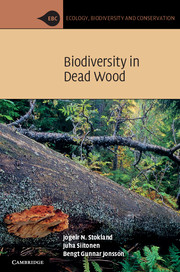Book contents
- Frontmatter
- Contents
- Preface
- 1 Introduction
- 2 Wood decomposition
- 3 The saproxylic food web
- 4 Other associations with dead woody material
- 5 Host-tree associations
- 6 Mortality factors and decay succession
- 7 Microhabitats
- 8 Tree size
- 9 The surrounding environment
- 10 Evolution of saproxylic organisms
- 11 Species diversity of saproxylic organisms
- 12 Natural forest dynamics
- 13 Dead wood and sustainable forest management
- 14 Population dynamics and evolutionary strategies
- 15 Threatened saproxylic species
- 16 Dead wood in agricultural and urban habitats
- 17 The value and future of saproxylic diversity
- References
- Index
5 - Host-tree associations
Published online by Cambridge University Press: 05 June 2012
- Frontmatter
- Contents
- Preface
- 1 Introduction
- 2 Wood decomposition
- 3 The saproxylic food web
- 4 Other associations with dead woody material
- 5 Host-tree associations
- 6 Mortality factors and decay succession
- 7 Microhabitats
- 8 Tree size
- 9 The surrounding environment
- 10 Evolution of saproxylic organisms
- 11 Species diversity of saproxylic organisms
- 12 Natural forest dynamics
- 13 Dead wood and sustainable forest management
- 14 Population dynamics and evolutionary strategies
- 15 Threatened saproxylic species
- 16 Dead wood in agricultural and urban habitats
- 17 The value and future of saproxylic diversity
- References
- Index
Summary
Various textbooks have described the diversity of trees (Oldfield et al., 1998; Grandtner, 2005; Tudge, 2005) and another series of books have treated the internal anatomy, physiological functioning and defence mechanisms of trees (Blanchette and Biggs, 1992; Butin, 1995; Wagner et al., 2002; Schweingruber et al., 2006). In this chapter we describe trees from a different angle – how different tree properties have strong implications for the species composition of saproxylic species after the tree has died.
Like other topics in ecology, the host-tree associations of saproxylics must be understood in an evolutionary context. In Chapter 10 we examine the evolution of woody plants with an emphasis on structural innovations. Here we simply mention that the origin of coniferous trees dates from about 310 million years back in time, while different broadleaved trees first evolved 100–120 million years ago (mya). Thus, coniferous trees and broadleaved trees represent distinct plant groups which differ in many ways.
Conifers versus broadleaved trees
There is a striking lack of scientific review publications that provide quantitative information about host-tree associations among woodinhabiting organisms. In a recent book on the ecology of wooddecaying basidiomycetes (Boddy et al., 2008 ), the topic of host-tree associations was only superi cially treated. Only one chapter touched on this subject and quantified the proportion of fungi in Denmark that were specific, strongly selective, or weakly selective for different broadleaved tree species (Boddy and Heilmann-Clausen, 2008 ). The corresponding chapter on fungal communities in boreal, conifer- dominated forests did not mention host-tree associations at all. Similarly, a quite recent French book on forest insects (Dajoz, 2000 ), with a broad treatment of saproxylic insects, did not deal with host-tree association patterns explicitly. Dajoz was, of course, aware of such associations, since his chapter on community development during the decomposition process was subdivided into sections treating different tree species individually. Such treatments of community composition in wood from separate tree species are quite common (see Chapter 6 ). But it is only when information is brought together from many sources that we can get a broader overview of host-tree ranges and the specific preferences of wood-inhabiting species.
- Type
- Chapter
- Information
- Biodiversity in Dead Wood , pp. 82 - 109Publisher: Cambridge University PressPrint publication year: 2012
- 8
- Cited by



